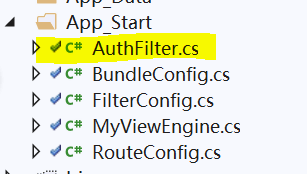笔记三 过滤器应用之防止非法登录

1. 在 App_Start 下新增一个 AuthFilter.cs
public class HandlerLoginAttribute : AuthorizeAttribute { public override void OnAuthorization(AuthorizationContext filterContext) { base.OnAuthorization(filterContext); } /// <summary> /// 满足条件 /// </summary> /// <param name="httpContext"></param> /// <returns></returns> protected override bool AuthorizeCore(HttpContextBase httpContext) { string url= httpContext.Request.RawUrl; Common.OperatorProvider provider = Common.OperatorProvider.Provider; if (provider.GetCurrent()!=null) { return true; } return false; } /// <summary> /// 不满足条件执行 /// </summary> /// <param name="filterContext"></param> protected override void HandleUnauthorizedRequest(AuthorizationContext filterContext) { filterContext.HttpContext.Response.Redirect("/Login/Index"); //不加这句话还是会执行请求的方法 base.HandleUnauthorizedRequest(filterContext); return; }
注册全局变量

2.在以下的方法 标注允许所有用户访问,跳过验证,否则就永远登录不了
[AllowAnonymous] //容许所有的用户访问 public ActionResult LoginPage() { return View(); } [AllowAnonymous] public string Login(string userCode, string passWord) { try { DAL.sys.UserInfo user = new DAL.sys.UserInfo(); if (userCode == "admin" && passWord == "123456") { DataTable admin_dt = user.GetAllMenu(); Session["EmpCode"] = "admin"; Common.CreateTree tree = new Common.CreateTree(); //DataTable dtMenu = user.GetMenuByUser(userCode); string jsonData = JsonConvert.SerializeObject(tree.BindTree(admin_dt, null, "0")); return "{\"success\":true,\"data\":" + jsonData + "} "; } else { DataTable dt = user.GetUserInfoByuserCode(userCode); if (dt.Rows.Count == 0) { return "{\"success\":false,\"msg\":\" 该用户不存在!\"}"; } else { if (dt.Rows[0]["PassWord"].ToString() != passWord) { return "{\"success\":false,\"msg\":\" 密码错误!\"}"; } else { Session["EmpCode"] = dt.Rows[0]["EmpCode"].ToString(); Common.CreateTree tree = new Common.CreateTree(); DataTable dtMenu = user.GetMenuByUser(userCode); string jsonData = JsonConvert.SerializeObject(tree.BindTree(dtMenu, null, "0")); return "{\"success\":true,\"data\":" + jsonData + "} "; } } } } catch(Exception ex) { return ex.Message; } }



